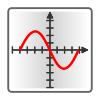Questa voce o sezione sull'argomento matematica non cita le fonti necessarie o quelle presenti sono insufficienti.
In matematica, le regole di derivazione e le derivate fondamentali sono regole studiate per evitare di dover calcolare ogni volta il limite del rapporto incrementale di funzioni, e utilizzate al fine di facilitare la derivazione di funzioni di maggiore complessità.
Regole di derivazione
Siano  e
e  funzioni reali di variabile reale
funzioni reali di variabile reale  derivabili, e sia
derivabili, e sia  l'operazione di derivazione rispetto a
l'operazione di derivazione rispetto a  :
:
![{\displaystyle \mathrm {D} [f(x)]=f'(x),\qquad \mathrm {D} [g(x)]=g'(x).}](https://wikimedia.org/api/rest_v1/media/math/render/svg/9a3dbbee591cfc03840aee7b3156fbb214dc15c9)
- Regola della somma (linearità):
![{\displaystyle \mathrm {D} [\alpha f(x)+\beta g(x)]=\alpha f'(x)+\beta g'(x),\qquad \alpha ,\beta \in \mathbb {R} .}](https://wikimedia.org/api/rest_v1/media/math/render/svg/b9a6500ce06fa522a6c5d5a6c9e3b8a2579055ad)
- Regola del prodotto (o di Leibniz):
![{\displaystyle \mathrm {D} [{f(x)\cdot g(x)}]=f'(x)\cdot g(x)+f(x)\cdot g'(x).}](https://wikimedia.org/api/rest_v1/media/math/render/svg/74398f82204979f9097b8f0c739a7fb72bf9dd4f)
![{\displaystyle \mathrm {D} \left[{f(x) \over g(x)}\right]={f'(x)\cdot g(x)-f(x)\cdot g'(x) \over g(x)^{2}}.}](https://wikimedia.org/api/rest_v1/media/math/render/svg/6f5ab95aa8459c3cd59bb25cd94dcb9be7beca56)
![{\displaystyle \mathrm {D} \left[{1 \over f(x)}\right]=-{f'(x) \over f(x)^{2}}.}](https://wikimedia.org/api/rest_v1/media/math/render/svg/8ab55df5e27c8a878d420d8bb9b5297a7ac46713)
![{\displaystyle \mathrm {D} [f^{-1}(x)]={1 \over f'(f^{-1}(x))}.}](https://wikimedia.org/api/rest_v1/media/math/render/svg/e06882f1975b6d8fa37dd57fcd36cd0cecc0c6f5)
![{\displaystyle \mathrm {D} \left[f\left(g(x)\right)\right]=f'\left(g(x)\right)\cdot g'(x).}](https://wikimedia.org/api/rest_v1/media/math/render/svg/2817599e9674d0fc0091e8c197a91595e3e4ff29)
![{\displaystyle \mathrm {D} \left[f(x)^{g(x)}\right]=f(x)^{g(x)}\left[g'(x)\ln(f(x))+{\frac {g(x)f'(x)}{f(x)}}\right].}](https://wikimedia.org/api/rest_v1/media/math/render/svg/5372f08f78cf6feb831e90307bb4f2eaed3fbb78)
Derivate fondamentali
Ognuna di queste funzioni, se non altrimenti specificato, è derivabile in tutto il suo campo di esistenza.
Funzioni polinomiali





Più in generale si ha:

Da quest'ultima relazione segue che se  è un polinomio generico di grado
è un polinomio generico di grado  , allora
, allora  è in generale un polinomio di grado
è in generale un polinomio di grado  .
.
Potenze, radici e valore assoluto

![{\displaystyle \mathrm {D} ({\sqrt[{2}]{x}})={\frac {1}{2{\sqrt[{2}]{x}}}}.}](https://wikimedia.org/api/rest_v1/media/math/render/svg/fa51b242cf9d670df7ee31a03ac62f2e67ffc33d)
![{\displaystyle \mathrm {D} ({\sqrt[{n}]{x^{m}}})={{\frac {m}{n}}{\sqrt[{n}]{x^{m-n}}}},\qquad {\text{se }}x>0.}](https://wikimedia.org/api/rest_v1/media/math/render/svg/b1b422f7b60f37c57b34c696546e2de446b0c5b6)

Funzioni logaritmiche ed esponenziali




























Derivate di funzioni composte

![{\displaystyle \mathrm {D} ([f(x)]^{n})=n\cdot f(x)^{n-1}\cdot f'(x).}](https://wikimedia.org/api/rest_v1/media/math/render/svg/acda3dc305bb142e50d63a30ffe67dabde6813d1)







![{\displaystyle D(\arcsin f(x))={f'(x) \over {\sqrt {1-[f(x)]^{2}}}}.}](https://wikimedia.org/api/rest_v1/media/math/render/svg/63fd316798cefbec6529fe48b94a637c4667bf29)
![{\displaystyle D(\arccos f(x))={-f'(x) \over {\sqrt {1-[f(x)]^{2}}}}.}](https://wikimedia.org/api/rest_v1/media/math/render/svg/394120c0b30ba4221a698d7dc4c6874ddcffdd5a)
![{\displaystyle D(\arctan f(x))={f'(x) \over 1+[f(x)]^{2}}.}](https://wikimedia.org/api/rest_v1/media/math/render/svg/d9544bbb24e2189c0c44f3f8537c5b34dfc5084d)
![{\displaystyle D(f(x)^{g(x)})=f(x)^{g(x)}\cdot \left[g'(x)\cdot \ln f(x)+g(x)\cdot {f'(x) \over f(x)}\right].}](https://wikimedia.org/api/rest_v1/media/math/render/svg/eba6b22fbae869aef2d2c9dd3f02a9d8d83b832a)
Dimostrazione
 e dunque si deriva seguendo la regola di
e dunque si deriva seguendo la regola di  e del prodotto.
e del prodotto.
![{\displaystyle D(x^{f(x)})=x^{f(x)}\cdot \left[f'(x)\cdot \ln x+{f(x) \over x}\right].}](https://wikimedia.org/api/rest_v1/media/math/render/svg/db26b76af91ca76fc8acaf7ee36494cd2603270c)
Voci correlate
 Portale Matematica
Portale Matematica: accedi alle voci di Wikipedia che trattano di matematica

 Portale Matematica: accedi alle voci di Wikipedia che trattano di matematica
Portale Matematica: accedi alle voci di Wikipedia che trattano di matematica



![{\displaystyle \mathrm {D} [f(x)]=f'(x),\qquad \mathrm {D} [g(x)]=g'(x).}](https://wikimedia.org/api/rest_v1/media/math/render/svg/9a3dbbee591cfc03840aee7b3156fbb214dc15c9)
![{\displaystyle \mathrm {D} [\alpha f(x)+\beta g(x)]=\alpha f'(x)+\beta g'(x),\qquad \alpha ,\beta \in \mathbb {R} .}](https://wikimedia.org/api/rest_v1/media/math/render/svg/b9a6500ce06fa522a6c5d5a6c9e3b8a2579055ad)
![{\displaystyle \mathrm {D} [{f(x)\cdot g(x)}]=f'(x)\cdot g(x)+f(x)\cdot g'(x).}](https://wikimedia.org/api/rest_v1/media/math/render/svg/74398f82204979f9097b8f0c739a7fb72bf9dd4f)
![{\displaystyle \mathrm {D} \left[{f(x) \over g(x)}\right]={f'(x)\cdot g(x)-f(x)\cdot g'(x) \over g(x)^{2}}.}](https://wikimedia.org/api/rest_v1/media/math/render/svg/6f5ab95aa8459c3cd59bb25cd94dcb9be7beca56)
![{\displaystyle \mathrm {D} \left[{1 \over f(x)}\right]=-{f'(x) \over f(x)^{2}}.}](https://wikimedia.org/api/rest_v1/media/math/render/svg/8ab55df5e27c8a878d420d8bb9b5297a7ac46713)
![{\displaystyle \mathrm {D} [f^{-1}(x)]={1 \over f'(f^{-1}(x))}.}](https://wikimedia.org/api/rest_v1/media/math/render/svg/e06882f1975b6d8fa37dd57fcd36cd0cecc0c6f5)
![{\displaystyle \mathrm {D} \left[f\left(g(x)\right)\right]=f'\left(g(x)\right)\cdot g'(x).}](https://wikimedia.org/api/rest_v1/media/math/render/svg/2817599e9674d0fc0091e8c197a91595e3e4ff29)
![{\displaystyle \mathrm {D} \left[f(x)^{g(x)}\right]=f(x)^{g(x)}\left[g'(x)\ln(f(x))+{\frac {g(x)f'(x)}{f(x)}}\right].}](https://wikimedia.org/api/rest_v1/media/math/render/svg/5372f08f78cf6feb831e90307bb4f2eaed3fbb78)



















![{\displaystyle \mathrm {D} (f(x))=\lim _{h\to 0}{{f(x+h)-f(x)} \over {h}}=\lim _{h\to 0}{\sum _{k=0}^{n}{a_{k}(x+h)^{k}}-\sum _{k=0}^{n}{a_{k}x^{k}} \over h}=\lim _{h\to 0}{\sum _{k=0}^{n}{a_{k}\left[(x+h)^{k}-x^{k}\right]} \over h}}](https://wikimedia.org/api/rest_v1/media/math/render/svg/931e62d3198e1e2dd942926fe28f9290683410f7)


![{\displaystyle \mathrm {D} ({\sqrt[{2}]{x}})={\frac {1}{2{\sqrt[{2}]{x}}}}.}](https://wikimedia.org/api/rest_v1/media/math/render/svg/fa51b242cf9d670df7ee31a03ac62f2e67ffc33d)
![{\displaystyle \mathrm {D} ({\sqrt[{n}]{x^{m}}})={{\frac {m}{n}}{\sqrt[{n}]{x^{m-n}}}},\qquad {\text{se }}x>0.}](https://wikimedia.org/api/rest_v1/media/math/render/svg/b1b422f7b60f37c57b34c696546e2de446b0c5b6)



![{\displaystyle \mathrm {D} ({\sqrt[{n}]{x^{m}}})=\mathrm {D} \left(x^{\frac {m}{n}}\right).}](https://wikimedia.org/api/rest_v1/media/math/render/svg/69188f3a2a8efe1f5c142dd7c96dd29839734009)

![{\displaystyle \mathrm {D} ({\sqrt[{n}]{x^{m}}})={\frac {m}{n}}x^{{\frac {m}{n}}-1}={\frac {m}{n}}x^{\frac {m-n}{n}}={\frac {m}{n}}{\sqrt[{n}]{x^{m-n}}}.}](https://wikimedia.org/api/rest_v1/media/math/render/svg/52afce82b7b278fd9f8250a5aa44a2cfc666a5f6)











































































![{\displaystyle \mathrm {D} ([f(x)]^{n})=n\cdot f(x)^{n-1}\cdot f'(x).}](https://wikimedia.org/api/rest_v1/media/math/render/svg/acda3dc305bb142e50d63a30ffe67dabde6813d1)







![{\displaystyle D(\arcsin f(x))={f'(x) \over {\sqrt {1-[f(x)]^{2}}}}.}](https://wikimedia.org/api/rest_v1/media/math/render/svg/63fd316798cefbec6529fe48b94a637c4667bf29)
![{\displaystyle D(\arccos f(x))={-f'(x) \over {\sqrt {1-[f(x)]^{2}}}}.}](https://wikimedia.org/api/rest_v1/media/math/render/svg/394120c0b30ba4221a698d7dc4c6874ddcffdd5a)
![{\displaystyle D(\arctan f(x))={f'(x) \over 1+[f(x)]^{2}}.}](https://wikimedia.org/api/rest_v1/media/math/render/svg/d9544bbb24e2189c0c44f3f8537c5b34dfc5084d)
![{\displaystyle D(f(x)^{g(x)})=f(x)^{g(x)}\cdot \left[g'(x)\cdot \ln f(x)+g(x)\cdot {f'(x) \over f(x)}\right].}](https://wikimedia.org/api/rest_v1/media/math/render/svg/eba6b22fbae869aef2d2c9dd3f02a9d8d83b832a)


![{\displaystyle D(x^{f(x)})=x^{f(x)}\cdot \left[f'(x)\cdot \ln x+{f(x) \over x}\right].}](https://wikimedia.org/api/rest_v1/media/math/render/svg/db26b76af91ca76fc8acaf7ee36494cd2603270c)












